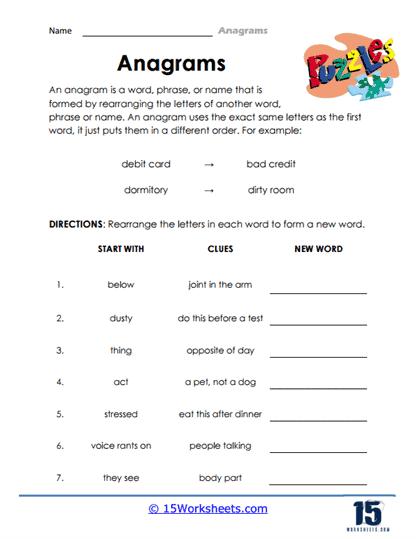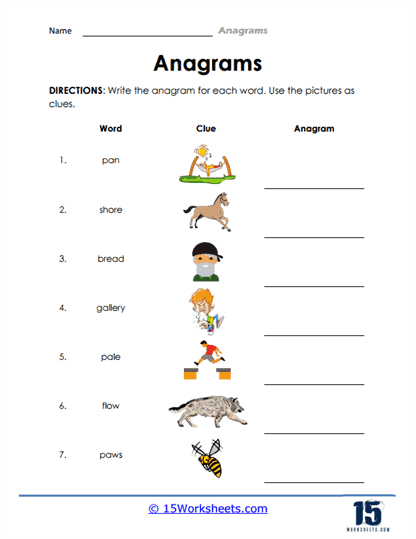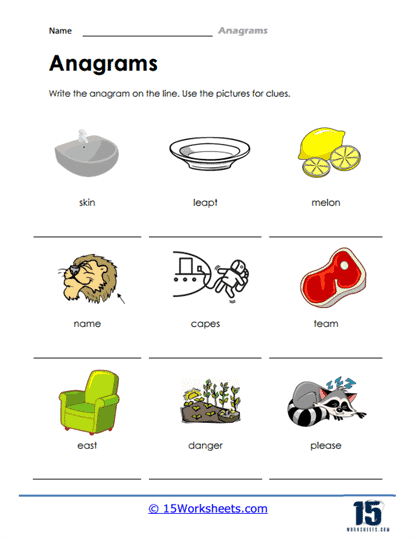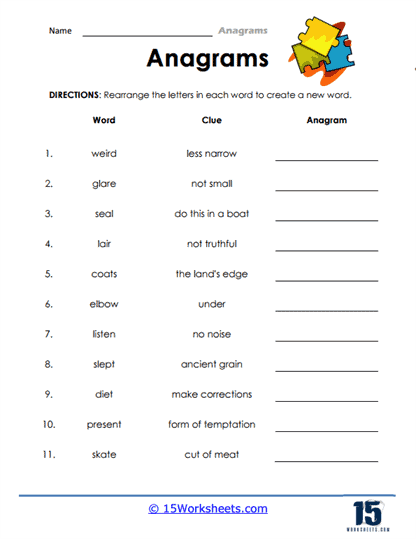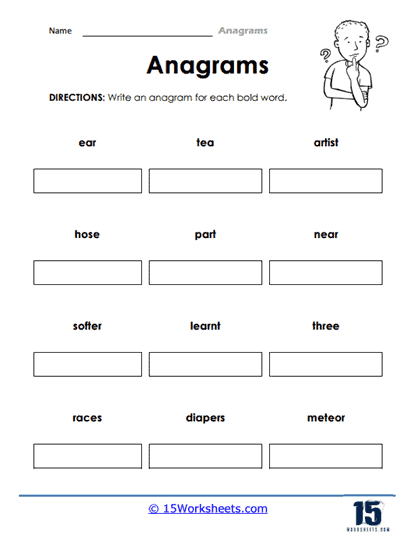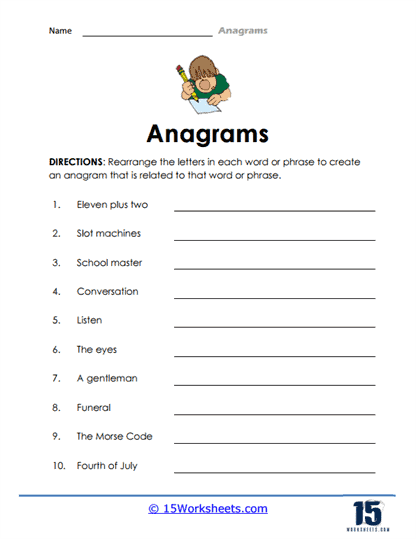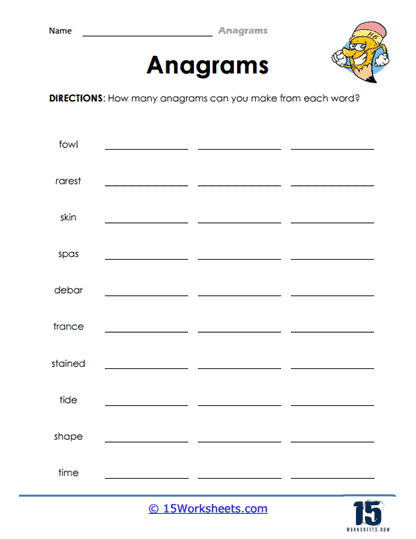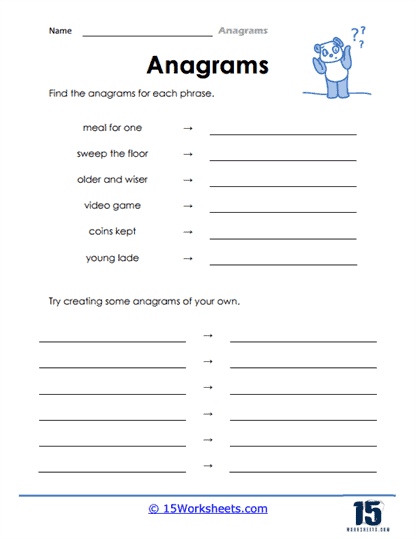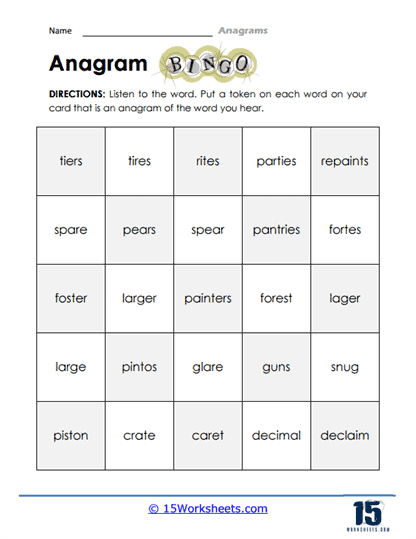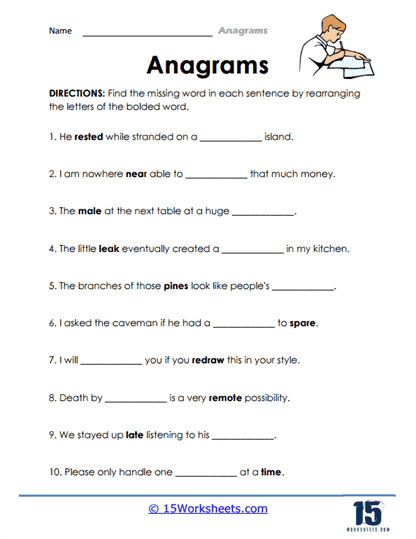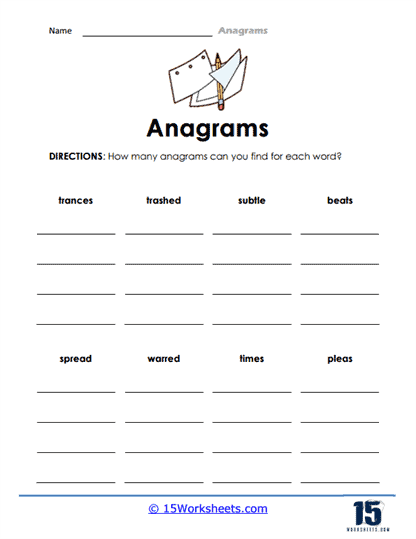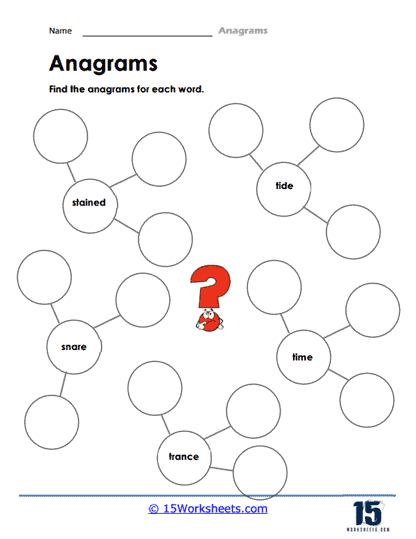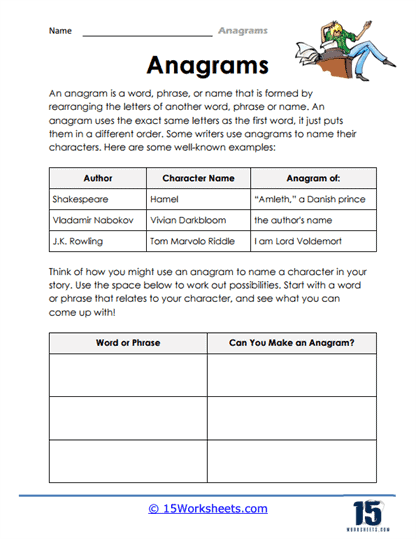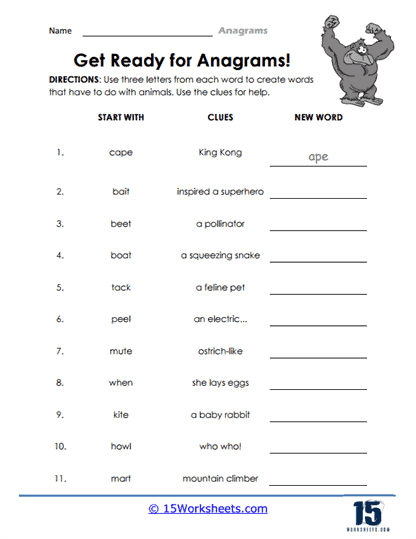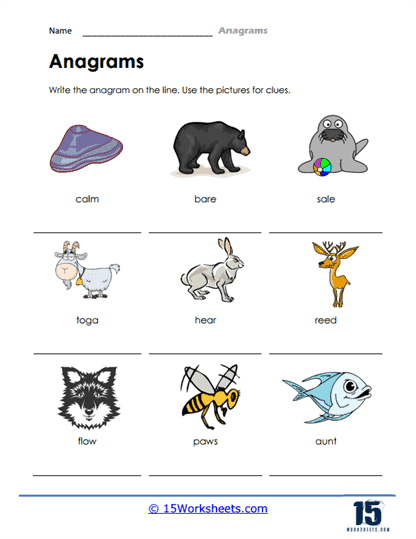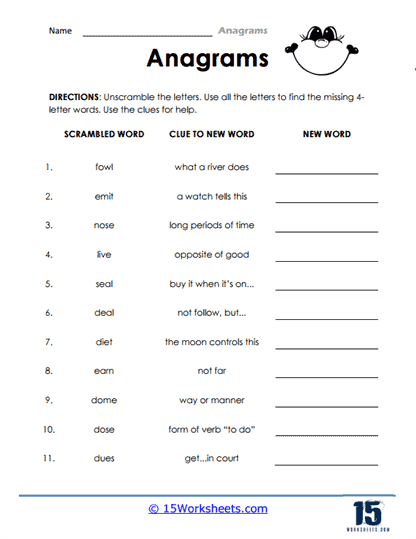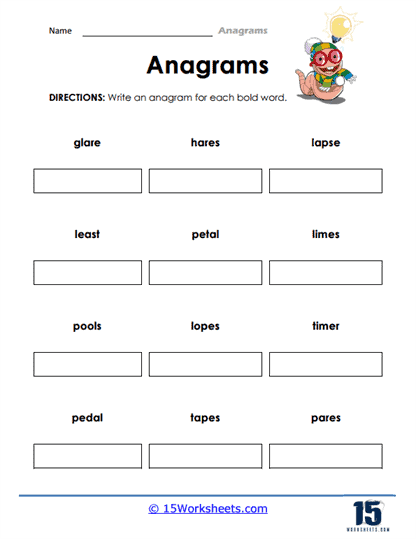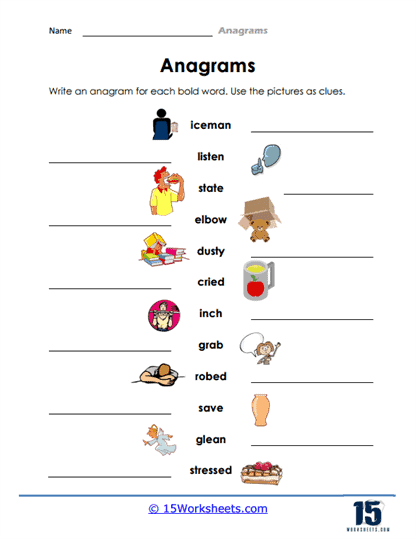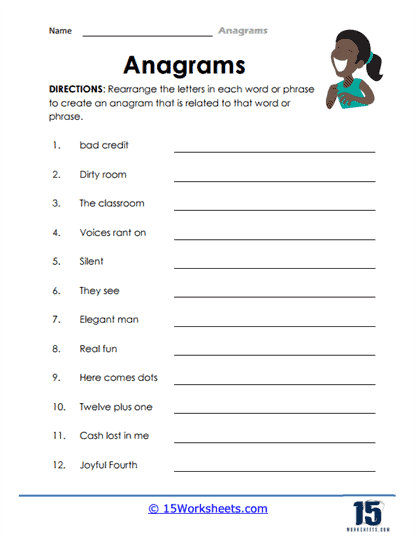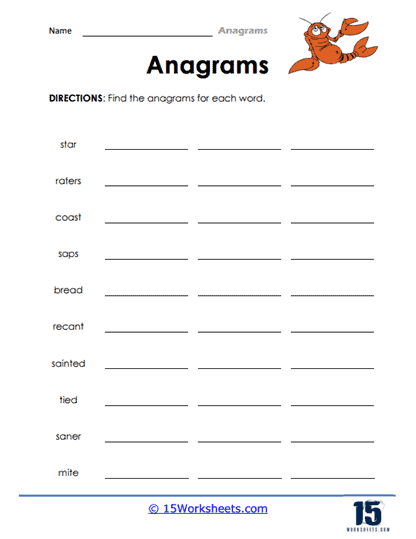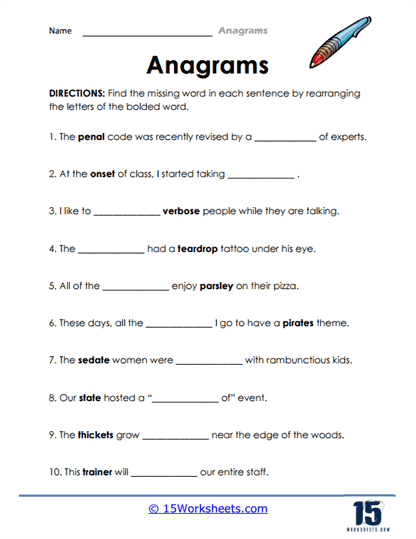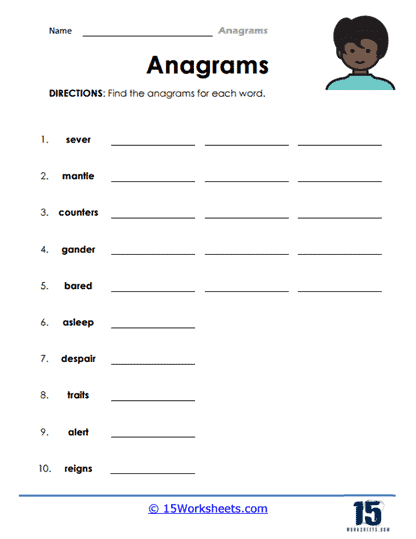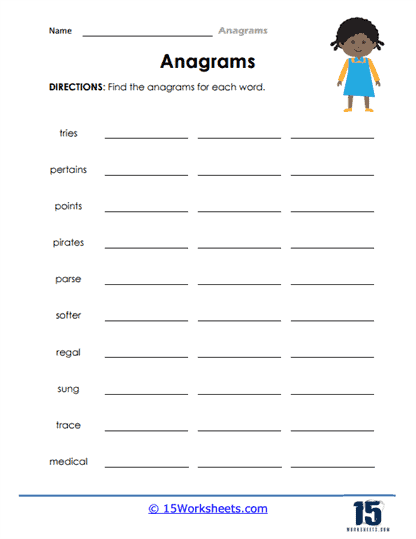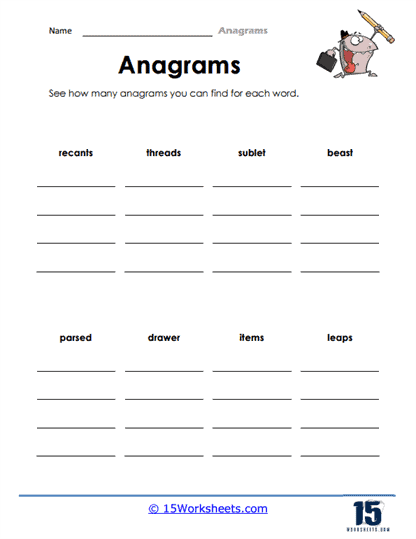Anagrams Worksheets
All About These Worksheets
Anagrams, the playful rearrangement of letters to create new words or phrases, are a delightful linguistic puzzle that sparks creativity, enhances vocabulary, and sharpens cognitive skills. Understanding and mastering anagrams is not only fun but also beneficial for young learners as it promotes word recognition, spelling proficiency, and critical thinking. In an educational landscape where language skills are pivotal, students must develop the ability to unlock the secrets of anagrams.
To empower students with the joy of wordplay and the benefits of anagram mastery, we proudly present a collection of Anagrams worksheets. These worksheets are meticulously designed to provide students with structured and engaging opportunities to explore, create, and solve anagrams.
What Are Anagrams Worksheets?
Anagram worksheets are like fun puzzles that help you play with words and letters. An anagram is when you rearrange the letters of a word or phrase to make a new word or phrase. These worksheets give you a set of letters and ask you to figure out all the different words that can be made by rearranging those letters.
In these worksheets, you’ll see a bunch of letters jumbled up together, and your task is to find as many words as you can by rearranging those letters. For example, if you have the letters “cat,” you could make words like “act” or “tac.” It’s like a word-building challenge!
The goal of anagram worksheets is to help you improve your vocabulary, spelling, and word recognition skills. They can be a fun way to discover new words and learn how different letters can make various combinations.
Why Do Authors Use Anagrams As A Literary Device?
Authors use anagrams as a literary device for several reasons. Here are five very common examples:
Concealing Messages
Authors may use anagrams to hide secret messages or hints within their writing. By rearranging letters, they can encode information that astute readers can decipher. For example, in J.K. Rowling’s “Harry Potter” series, the name “Tom Marvolo Riddle” can be rearranged to reveal the anagram “I am Lord Voldemort,” which signifies the character’s true identity and adds an element of mystery to the story.
Adding Symbolism or Foreshadowing
Anagrams can be employed to add symbolic meaning or foreshadow events in a story. Authors may cleverly rearrange letters to create words or phrases that hint at upcoming plot developments or thematic elements. In Agatha Christie’s mystery novel “The A.B.C. Murders,” the anagram “A.B.C.” is used to represent the murderer’s signature, as well as to signal the alphabetical order in which the victims are targeted.
Enhancing Wordplay and Humor
Anagrams can be used to create wordplay and humorous effects in writing. Authors may playfully rearrange letters to create clever puns, humorous phrases, or unexpected connections. For instance, in Lewis Carroll’s “Alice’s Adventures in Wonderland,” the anagram “Dormouse” becomes “Doze-mouse,” which humorously captures the sleepy nature of the character.
Character Names and Identities
Authors sometimes use anagrams to give depth or meaning to character names. By rearranging letters, they can create names that reflect a character’s personality, background, or role in the story. In Charles Dickens’ novel “Oliver Twist,” the character Edward Leeford is also known as “Monks,” an anagram that hints at his deceptive and villainous nature.
Generating Literary Challenges
Anagrams can be used as a playful and interactive literary device, engaging readers in puzzles or challenges. Authors may include anagrams within their work to invite readers to decipher or unravel hidden messages. For example, Dan Brown’s novel “The Da Vinci Code” incorporates various anagrams that readers can solve alongside the characters to uncover secret codes and historical clues.
The Importance of Understanding Anagrams For Students
Understanding anagrams and their various forms is of great importance for several reasons:
- Vocabulary Expansion: Engaging with anagrams exposes students to a wide range of words and phrases, expanding their vocabulary.
- Spelling Proficiency: Creating and solving anagrams enhances spelling skills as students must correctly rearrange letters to form words.
- Critical Thinking: Anagram puzzles require logical thinking and problem-solving skills, fostering mental agility.
- Language Play: Anagrams encourage a playful and creative approach to language, making learning enjoyable and memorable.
Benefits Of These Anagrams Worksheets
These Anagrams worksheets offer numerous advantages for students:
- Structured Learning: The worksheets are thoughtfully organized to provide students with a structured learning experience. They progress from basic anagram concepts to more complex wordplay challenges, ensuring a comprehensive understanding.
- Engaging Activities: Each worksheet incorporates fun and interactive activities, including anagram decoding, word search, crossword puzzles, and creative anagram creation. These activities make learning about anagrams enjoyable, keeping students motivated and interested.
- Versatility: These worksheets can be used in various educational settings, including language arts classes, literacy programs, and puzzle clubs. They are adaptable to students of different ages and proficiency levels.
- Enhanced Word Skills: Proficiency in creating and solving anagrams sharpens students’ word recognition, spelling, and vocabulary development.
- Improved Critical Thinking: Anagram puzzles challenge students’ critical thinking and problem-solving abilities, boosting cognitive skills.
This collection of Anagrams worksheets is a valuable resource for educators and parents committed to nurturing language skills, critical thinking, and wordplay in students. Proficiency in creating and solving anagrams equips individuals with the tools to excel in language arts, expand their vocabulary, and enjoy the beauty of linguistic creativity.
This collection is an investment in their future success, ensuring they have the language skills to express themselves eloquently and tackle linguistic challenges with confidence. Explore these Anagrams worksheets, and watch your students embark on a journey of wordplay, creativity, and language mastery.

